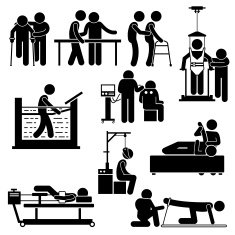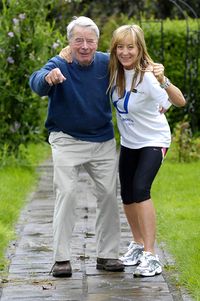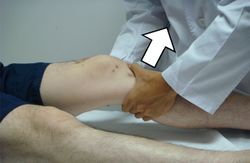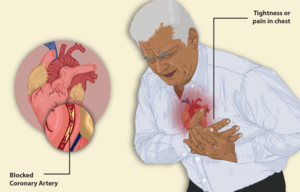Benefits of Rehabilitation
Original Editors - Neha Duhan
Top Contributors - Naomi O'Reilly, Neha Duhan, Kim Jackson, Shaimaa Eldib, Oyemi Sillo, Olajumoke Ogunleye, Aminat Abolade, Merinda Rodseth, Admin, Lucinda hampton and Ashmita Patrao
Introduction[edit | edit source]
Rehabilitation is defined as ‘a set of interventions designed to optimize functioning and reduce disability in individuals with health conditions in interaction with their environment’ Rehabilitation helps a child, adult or older person to be as independent as possible in daily life activities and allows them to participate in work, recreation and life roles.[1] It enables them to do so by addressing underlying conditions and improving their way of performing everyday activities, supporting them to overcome difficulties with thinking, communicating or walking around. Any person may need rehabilitation at some point in their lives such as due to injury, surgery, any disease or decrease in mobility due to age factor.
The rehabilitation process involves six major areas of focus:
- preventing, recognizing, and managing comorbid illness and medical complication
- training for maximum independence
- facilitating maximum psychosocial coping and adaptation by patient and family
- preventing secondary disability by promoting community reintegration, including resumption of home, family, recreational, and vocational activities
- enhancing quality of life in view of residual disability
- preventing recurrent conditions.
Physical Benefits[edit | edit source]
- Increased physical capacity [2]
- Lessens pain so patient can become more active and enjoy life without suffering from discomfort.
- Strengthens muscles to lessen risk of falls or accidents
- Improves coordination for better mobility and easier movement.
- Improves flexibility – physical therapy for injury can help in achieving a full range of motion in the joints and muscles.
- Reduces swelling in the affected joints and muscles.
- Helps improve your balance.[3]
- Prevents deformities and limb problems.[4]
- Corrects your gait and posture problems.[3]
Psychological Benefits [edit | edit source]
- Enhances your self-confidence and your ability to deal psychologically with your illness or injury.
- Provides you with greater independence – returns you to your pre-injury state of mental wellbeing.
Lifestyle Benefits[edit | edit source]
- Allows you to get back to work more quickly so you can begin to earn again and lessen your financial concerns.[4]
- Helps you return to sport or exercise so your health and your sense of wellbeing can benefit – you also improve your general health when you can exercise or play sport to your original capacities.
Types[edit | edit source]
Orthopedic and Musculoskeletal Rehabilitation[edit | edit source]
It is a therapeutic approach to recovery, the purpose of which is to correct musculoskeletal limitations and alleviate pain from trauma, illness, or surgery. The Musculoskeletal system includes muscles, bones, joints, ligaments, tendons, cartilage so that orthopedic rehab can address any of those structures. Conditions which require rehabilitation the most are:
- Carpal tunnel
- Arthritis
- Osteoporosis
- ACL and meniscus tears
- Broken bones
- Hip, knee, or shoulder replacement
- Stroke
- Sciatica
- Amputation
Physiotherapist creates a personalized treatment program according to condition, goals and abilities of patient. Physical therapists uses a variety of techniques to help muscles and joints work to improving, maintaining or restoring physical strength, cognition and mobility with maximized results.[4] Many of the reviews concluded that both aerobic and strengthening exercise, as well as individual and group exercise, are effective in patients with knee osteoarthritis.[5]
Neurological Rehabilitation[edit | edit source]
Some of the common conditions like Spinal Cord Injury, Stroke, Multiple Sclerosis, Parkinsons may present with varying degrees of spasticity, muscle weakness, impaired coordination and balance, difficult in speech and swallowing. Individuals with a neurological condition can show great potential for recovery in both the early and late stages of rehabilitation following injury. Enhancement of the recovery process could be achieved with new rehabilitation approaches alone or in combination with pharmacological intervention.[6] For example rehabilitation of movement after stroke requires repeated practice and involves learning and brain changes. Brain stimulation plays a crucial role in treating stroke patients.[7]
If an individual is having difficulties with activities of daily living, rehabilitation can support them in developing strategies to accomplish the same tasks in different way or through the use of assistive technology. Physiotherapy and occupational therapy can help patients improve their activities of daily living as well as their mobility. Practical techniques and assistive devices may ease the burden of dressing, bathing, eating, household chores, and daily care. Vestibular rehabilitation attempts to help patients adapt to balance problems. Some equipment has been designed to improve stability. Assistive devices, hand rails, and safety training can reduce the risk of falling.[3] Overall, exercise can improve fitness and function and maintain function for those with moderate to severe impairment.[8]
Cardiac Rehabilitation[edit | edit source]
Cardiac rehabilitation is a complex intervention offered to individuals with cardiovascular disease or following a myocardial infarction, which includes components of health education, advice on risk reduction, physical activity and stress management. These programs are designed to limit the physiological and psychological effects of cardiac illness, reduce the risk for sudden death or re-infarction, control cardiac symptoms, stabilize or reverse the atherosclerotic process, and enhance the psychosocial and vocational status of patients. cardiac rehabilitation reduces mortality, morbidity, unplanned hospital admissions in addition to improvements in exercise capacity, quality of life and psychological well-being is increasing.[10] In addition to these benefits, upper extremity exercises and instruction on breathing technique are included in most rehabilitation programs and reduce dyspnea.
Pulmonary Rehabilitation[edit | edit source]
Pulmonary rehabilitation is a “comprehensive intervention based on a thorough patient assessment followed by patient-tailored therapies that include, but are not limited to, exercise training, education, and behavior change, designed to improve the physical and psychological condition of people with chronic respiratory disease and to promote the long-term adherence to health-enhancing behaviors”[11]
Pulmonary rehabilitation is tailored to the individual who has recently had an exacerbation, with the aim of optimizing their respiratory function and therefore their quality of life (QOL) and participation in their everyday lives. PR has been proven to significantly improve health related Quality of life (QOL) and exercise capacity in individuals with Chronic Respiratory Pulmonary Disorder (COPD) compared to usual care[4]. Studies suggest PR is useful in patients with moderate to severe COPD[12]. A prospective, multisite, randomised controlled trial will determine whether an 8-week PR programme (exercise training will comprise: overground or treadmill walking, lower limb stationary cycling, lower and upper limb strengthening exercises) is equivalent to a 12-week PR programme in people with COPD[13].
Increased functional exercise capacity, and enhanced quality of life of patients with chronic obstructive pulmonary disease (COPD) are established benefits of pulmonary rehabilitation.[14]
Resources[edit | edit source]
References [edit | edit source]
- ↑ https://www.who.int/news-room/fact-sheets/detail/rehabilitation
- ↑ Smith TP, Kennedy SL, Smith M, Orent S, Fleshner M. Physiological improvements and health benefits during an exercise-based comprehensive rehabilitation program in medically complex patients. Exerc Immunol Rev. 2006 Jan 1;12:86-96.
- ↑ 3.0 3.1 3.2 Burks JS, Bigley GK, Hill HH. Rehabilitation challenges in multiple sclerosis. Annals of Indian Academy of Neurology. 2009 Oct;12(4):296.
- ↑ 4.0 4.1 4.2 4.3 Ghasemi N, Razavi S, Nikzad E. Multiple sclerosis: pathogenesis, symptoms, diagnoses and cell-based therapy. Cell Journal (Yakhteh). 2017 Apr;19(1):1. Cite error: Invalid
<ref>tag; name ":1" defined multiple times with different content - ↑ Jamtvedt G, Dahm KT, Christie A, Moe RH, Haavardsholm E, Holm I, Hagen KB. Physical therapy interventions for patients with osteoarthritis of the knee: an overview of systematic reviews. Physical therapy. 2008 Jan 1;88(1):123-36.
- ↑ Barbeau H, Fung J. The role of rehabilitation in the recovery of walking in the neurological population. Current opinion in neurology. 2001 Dec 1;14(6):735-40.
- ↑ Allman C, Amadi U, Winkler AM, Wilkins L, Filippini N, Kischka U, Stagg CJ, Johansen-Berg H. Ipsilesional anodal tDCS enhances the functional benefits of rehabilitation in patients after stroke. Science translational medicine. 2016 Mar 16;8(330):330re1-.
- ↑ Brown TR, Kraft GH. Exercise and rehabilitation for individuals with multiple sclerosis. Physical medicine and rehabilitation clinics of North America. 2005 May 1;16(2):513-55.
- ↑ World Health Organisation (WHO). Rehabilitation changes lives – Sana’s story from Pakistan. Available from: https://youtu.be/cy3xqEApmPI[last accessed 20/06/2021]
- ↑ Dalal HM, Doherty P, Taylor RS. Cardiac rehabilitation. Bmj. 2015 Sep 29;351.
- ↑ Spruit MA, Singh SJ, Garvey C, ZuWallack R, Nici L, Rochester C, Hill K, Holland AE, Lareau SC, Man WD, et al.; ATS/ERS Task Force on Pulmonary Rehabilitation. An official American Thoracic Society/ European Respiratory Society statement: key concepts and advances in pulmonary rehabilitation. Am J Respir Crit Care Med 2013;188:e13–e64.
- ↑ Lee AL, Butler SJ, Varadi RG, Goldstein RS, Brooks D. The Impact of Pulmonary Rehabilitation on Chronic Pain in People with COPD. COPD: Journal of Chronic Obstructive Pulmonary Disease. 2020 Mar 3;17(2):165-74.
- ↑ Bishop J, Spencer L, Alison J. Effect of a pulmonary rehabilitation programme of 8 weeks compared to 12 weeks duration on exercise capacity in people with chronic obstructive pulmonary disease (PuRe Duration): protocol for a randomised controlled trial. BMJ open respiratory research. 2020 Sep 1;7(1):e000687.
- ↑ McCarthy B, Casey D, Devane D, Murphy K, Murphy E, Lacasse Y. Pulmonary rehabilitation for chronic obstructive pulmonary disease. Cochrane database of systematic reviews. 2015(2).










